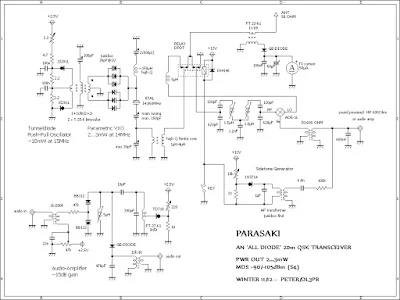 JBOD! FB!
JBOD! FB!Hi folks,
I'd like to share with you a long-cherished dream, that recently came true, forty years after I came to read about hams using tunnel diodes to make QSOs when I was aged twelve or so:
Finally I managed a first skywave QSO with my PARASAKI-transceiver, an 'all diode' rig: Christophe/F8DZY replied to my very first call on 20m band in REF-contest last weekend. I was running 2mW into a temporary vertical dipole on my balcony. Distance between us is 918km - obviously OM Christophe has excellent ears.
Those interested in the cruel details of my circuit, please find attached a schematic and a photo of the pretty ugly setup. The circuit is designed straight-forward with exception of the parametric VXO, derived from Mike/AA1TJ's famous Paraceiver design. (see http://fhs-consulting.com/aa1tj/paraceiver.html )
The low impedance of the high peak-current tunnel diodes make it very difficult to built a really crystal controlled oscillator rather than an LC-oscillator, synchronized by the crystal more or less, at least on the higher SW-bands. The Parametric VXO provides a crystal-stable, chirp-free signal on expense of an output power of two milliwatts only instead of ten, but with an amazing spectral purity, no need for a low pass filter or such. Of course it sounds pretty cool making a QSO with a 'bunch of diodes' and a parametrically excited crystal, but believe me or not, I'd preferred to bring that full ten milliwatt into the air - on the other hand that approach allowed to tune the rig a bit ( ~ 5kHz/per xtal), which turned out to be much more valuable than a few milliwatts more while being 'rock-bound'.
The receiver in its 'gain-less' version works fine for strong signals - while listening to QRP(p) stations, the moderate gain of the audio amplifier helps a lot. A comfortable frequency shift between receive and transmit is realized by the 5µH inductor at the LO-port of the mixer, with little effect on sensitivity.
Thanks for the bandwidth, OMs, won't bother again you with such mails, unless I make a cross-pond QSO with that rig ( not that likely ) or any skywave QSO with homemade semiconductors ( probably impossible )...
72!
Peter/DL3PB

Our book: "SolderSmoke -- Global Adventures in Wireless Electronics"http://soldersmoke.com/book.htmOur coffee mugs, T-Shirts, bumper stickers: http://www.cafepress.com/SolderSmokeOur Book Store: http://astore.amazon.com/contracross-20
Bill,
ReplyDeleteI read about your problems with power amplifier stability in the blog and wanted to tell you a bit about parametric oscillation but it is not an easy topic to explain in a short comment. Fortunately this post contains a link to Mike, AA1TJ's article on the "Paraceiver". http://fhs-consulting.com/aa1tj/paraceiver.html In that link is the clearest and best explanation of the phenomenon that I have ever seen. Read Mike's article and visualize an RF power amplifier: the pump source is the RF drive to the PA, The time varying capacitive reactance is provided by the collector-base junction of the power transistor and the series tuned resonators (or idlers) are stray resonances in the output impedance matching and DC feed circuits.
The DC feed choke and bypass capacitor can provide a low frequency idler, and stray resonances reflected from the output circuits can provide a higher frequency idler. If the sum of these two idler frequencies equals the pump frequency you can get parametric oscillation. It is hard to track down because it is not due to classic feedback and you have to think differently about it. Strategically placed ferrite beads can certainly help because they can "de-Q" the idlers.
Thanks to Mike for a very readable explanation of parametric oscillation.
Paul W2IOG
Hello OM Bill,
ReplyDeletethanks a lot for posting my story -
only could you please correct my
callsign in the headline on occasion.(DL3PB)
Meanwhile received an mp3 file of our QSO from Chris - my signal was weak, but not too hard to copy.
Keep up your great blog/podcast.
73
Peter/DL3PB
Mesmerized article written on this blog with other relevant information. It is straight to the point that how we can improve our skills as well as how we can be represented to a new stream of professionalism.
ReplyDeleteหลอด led